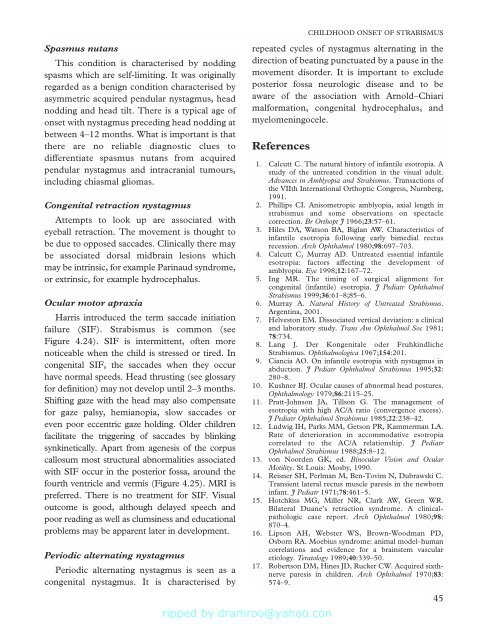Strabismus - Fundamentals of Clinical Ophthalmology.pdf
Strabismus - Fundamentals of Clinical Ophthalmology.pdf
Strabismus - Fundamentals of Clinical Ophthalmology.pdf
You also want an ePaper? Increase the reach of your titles
YUMPU automatically turns print PDFs into web optimized ePapers that Google loves.
CHILDHOOD ONSET OF STRABISMUS<br />
Spasmus nutans<br />
This condition is characterised by nodding<br />
spasms which are self-limiting. It was originally<br />
regarded as a benign condition characterised by<br />
asymmetric acquired pendular nystagmus, head<br />
nodding and head tilt. There is a typical age <strong>of</strong><br />
onset with nystagmus preceding head nodding at<br />
between 4–12 months. What is important is that<br />
there are no reliable diagnostic clues to<br />
differentiate spasmus nutans from acquired<br />
pendular nystagmus and intracranial tumours,<br />
including chiasmal gliomas.<br />
Congenital retraction nystagmus<br />
Attempts to look up are associated with<br />
eyeball retraction. The movement is thought to<br />
be due to opposed saccades. <strong>Clinical</strong>ly there may<br />
be associated dorsal midbrain lesions which<br />
may be intrinsic, for example Parinaud syndrome,<br />
or extrinsic, for example hydrocephalus.<br />
Ocular motor apraxia<br />
Harris introduced the term saccade initiation<br />
failure (SIF). <strong>Strabismus</strong> is common (see<br />
Figure 4.24). SIF is intermittent, <strong>of</strong>ten more<br />
noticeable when the child is stressed or tired. In<br />
congenital SIF, the saccades when they occur<br />
have normal speeds. Head thrusting (see glossary<br />
for definition) may not develop until 2–3 months.<br />
Shifting gaze with the head may also compensate<br />
for gaze palsy, hemianopia, slow saccades or<br />
even poor eccentric gaze holding. Older children<br />
facilitate the triggering <strong>of</strong> saccades by blinking<br />
synkinetically. Apart from agenesis <strong>of</strong> the corpus<br />
callosum most structural abnormalities associated<br />
with SIF occur in the posterior fossa, around the<br />
fourth ventricle and vermis (Figure 4.25). MRI is<br />
preferred. There is no treatment for SIF. Visual<br />
outcome is good, although delayed speech and<br />
poor reading as well as clumsiness and educational<br />
problems may be apparent later in development.<br />
Periodic alternating nystagmus<br />
Periodic alternating nystagmus is seen as a<br />
congenital nystagmus. It is characterised by<br />
repeated cycles <strong>of</strong> nystagmus alternating in the<br />
direction <strong>of</strong> beating punctuated by a pause in the<br />
movement disorder. It is important to exclude<br />
posterior fossa neurologic disease and to be<br />
aware <strong>of</strong> the association with Arnold–Chiari<br />
malformation, congenital hydrocephalus, and<br />
myelomeningocele.<br />
References<br />
1. Calcutt C. The natural history <strong>of</strong> infantile esotropia. A<br />
study <strong>of</strong> the untreated condition in the visual adult.<br />
Advances in Amblyopia and <strong>Strabismus</strong>. Transactions <strong>of</strong><br />
the VIIth International Orthoptic Congress, Nurnberg,<br />
1991.<br />
2. Phillips CI. Anisometropic amblyopia, axial length in<br />
strabismus and some observations on spectacle<br />
correction. Br Orthopt J 1966;23:57–61.<br />
3. Hiles DA, Watson BA, Biglan AW. Characteristics <strong>of</strong><br />
infantile esotropia following early bimedial rectus<br />
recession. Arch Ophthalmol 1980;98:697–703.<br />
4. Calcutt C, Murray AD. Untreated essential infantile<br />
esotropia: factors affecting the development <strong>of</strong><br />
amblyopia. Eye 1998;12:167–72.<br />
5. Ing MR. The timing <strong>of</strong> surgical alignment for<br />
congenital (infantile) esotropia. J Pediatr Ophthalmol<br />
<strong>Strabismus</strong> 1999;36:61–8;85–6.<br />
6. Murray A. Natural History <strong>of</strong> Untreated <strong>Strabismus</strong>.<br />
Argentina, 2001.<br />
7. Helveston EM. Dissociated vertical deviation: a clinical<br />
and laboratory study. Trans Am Ophthalmol Soc 1981;<br />
78:734.<br />
8. Lang J. Der Kongenitale oder Fruhkindliche<br />
<strong>Strabismus</strong>. Ophthalmologica 1967;154:201.<br />
9. Ciancia AO. On infantile esotropia with nystagmus in<br />
abduction. J Pediatr Ophthalmol <strong>Strabismus</strong> 1995;32:<br />
280–8.<br />
10. Kushner BJ. Ocular causes <strong>of</strong> abnormal head postures.<br />
<strong>Ophthalmology</strong> 1979;86:2115–25.<br />
11. Pratt-Johnson JA, Tillson G. The management <strong>of</strong><br />
esotropia with high AC/A ratio (convergence excess).<br />
J Pediatr Ophthalmol <strong>Strabismus</strong> 1985;22:238–42.<br />
12. Ludwig IH, Parks MM, Getson PR, Kammerman LA.<br />
Rate <strong>of</strong> deterioration in accommodative esotropia<br />
correlated to the AC/A relationship. J Pediatr<br />
Ophthalmol <strong>Strabismus</strong> 1988;25:8–12.<br />
13. von Noorden GK, ed. Binocular Vision and Ocular<br />
Motility. St Louis: Mosby, 1990.<br />
14. Reisner SH, Perlman M, Ben-Tovim N, Dubrawski C.<br />
Transient lateral rectus muscle paresis in the newborn<br />
infant. J Pediatr 1971;78:461–5.<br />
15. Hotchkiss MG, Miller NR, Clark AW, Green WR.<br />
Bilateral Duane’s retraction syndrome. A clinicalpathologic<br />
case report. Arch Ophthalmol 1980;98:<br />
870–4.<br />
16. Lipson AH, Webster WS, Brown-Woodman PD,<br />
Osborn RA. Moebius syndrome: animal model–human<br />
correlations and evidence for a brainstem vascular<br />
etiology. Teratology 1989;40:339–50.<br />
17. Robertson DM, Hines JD, Rucker CW. Acquired sixthnerve<br />
paresis in children. Arch Ophthalmol 1970;83:<br />
574–9.<br />
45










![SISTEM SENSORY [Compatibility Mode].pdf](https://img.yumpu.com/20667975/1/190x245/sistem-sensory-compatibility-modepdf.jpg?quality=85)





